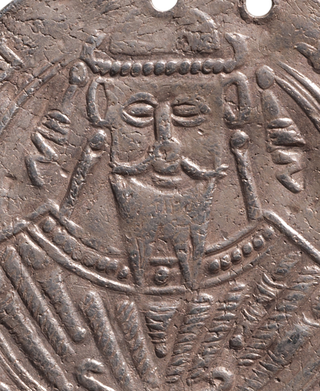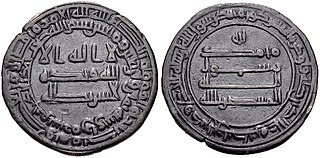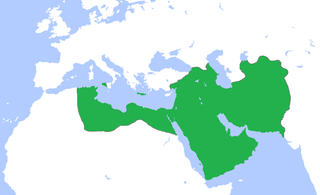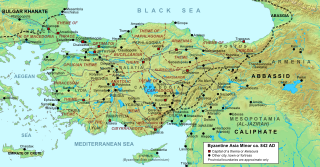The 850s decade ran from January 1, 850, to December 31, 859.
The 860s decade ran from January 1, 860, to December 31, 869.

Year 862 (DCCCLXII) was a common year starting on Thursday of the Julian calendar.

A nilometer is a structure for measuring the Nile River's clarity and water level during the annual flood season in Egypt. There were three main types of nilometers, calibrated in Egyptian cubits: (1) a vertical column, (2) a corridor stairway of steps leading down to the Nile, and (3) a deep well with a culvert. If the water level was low, the fertility of the floodplain would suffer. If it was too high, the flooding would be destructive. There was a specific mark that indicated how high the flood should be if the fields were to get good soil.

Abū Jaʿfar Hārūn ibn Muḥammad al-Wathiq bi'Llah, commonly known by his regnal name al-Wathiq bi'Llah, was an Abbasid caliph who reigned from 842 until his death in 847.

Ja'far ibn Muḥammad ibn Hārūn al-Mutawakkil ʿalā Allāh ; March 822 – 11 December 861, commonly known by his regnal name al-Mutawwakil ala Allah, was the tenth Abbasid caliph, ruling from 847 until his assassination in 861. He succeeded his brother, al-Wathiq, and is known for expanding the empire to its maximum extent. He was deeply religious, and is remembered for discarding the Muʿtazila, ending the Mihna, and releasing Ahmad ibn Hanbal. He is also known for his tough rule, especially with respect to non-Muslim subjects.

Abū al-ʿAbbās Aḥmad ibn Muḥammad ibn Kathīr al-Farghānī also known as Alfraganus in the West, was an astronomer in the Abbasid court in Baghdad, and one of the most famous astronomers in the 9th century. Al-Farghani composed several works on astronomy and astronomical equipment that were widely distributed in Arabic and Latin and were influential to many scientists. His best known work, Kitāb fī Jawāmiʿ ʿIlm al-Nujūmi, was an extensive summary of Ptolemy's Almagest containing revised and more accurate experimental data. Christopher Columbus used Al Farghani's calculations for his voyages to America. In addition to making substantial contributions to astronomy, al-Farghani also worked as an engineer, supervising construction projects on rivers in Cairo, Egypt. The lunar crater Alfraganus is named after him.

Abu Ja'far Muḥammad ibn Ja'far ibn Muḥammad ibn Hārūn al-Muntasir biʾLlāh, better known by his regnal title al-Muntasir biʾLlāh was the caliph of the Abbasid Caliphate from 861 to 862, during the "Anarchy at Samarra". The power struggle between al-Muntasir and his brother, al-Mu'tazz, backed by different factions, climaxed with the Turkic leaders plotting the murder of his father al-Mutawakkil. Following the assassination in 861, al-Muntasir assumed the caliphate with Turkic support.

Abū ʿAbd Allāh Muḥammad ibn Jaʿfar ibn Muḥammad ibn Hārūn al-Muʿtazz bi-ʾLlāh, better known by his regnal title al-Muʿtazz bi-ʾLlāh was the Abbasid caliph from 866 to 869, during a period of extreme internal instability within the Abbasid Caliphate, known as the "Anarchy at Samarra".
Abu Ja'far Ashinas was a general of the Abbasid caliph Al-Mu'tasim. One of the earliest and most prominent members of al-Mu'tasim's Turkic guard, he rose to become one of the leading figures of the empire under al-Mu'tasim, serving as a commander in the Amorium campaign, and playing a leading role in the purge of the old Abbasid elites that followed. He was also governor of Egypt from 834, as well as of the Levant and Upper Mesopotamia from 838 on, although in practice he appointed deputies to govern in his stead. Under al-Mu'tasim's successor al-Wathiq, his powers were extended further into a virtual viceroyalty over all western provinces of the caliphate.
Ibrahim ibn Jaʽfar al-Mutawakkil, better known by his laqabal-Mu'ayyad (المؤيد, was an Abbasid prince, the third son of the Abbasid caliph al-Mutawakkil, He was the governor of Syria from 850 to 861 and also for a time third-in-line to the Abbasid throne.

The Anarchy at Samarra was a period of extreme internal instability from 861 to 870 in the history of the Abbasid Caliphate, marked by the violent succession of four caliphs, who became puppets in the hands of powerful rival military groups.

The Capture of Faruriyyah in 862 was a military campaign conducted by the Abbasid Caliphate against the Byzantine Empire. Planned during the short caliphate of al-Muntasir, it was commanded by the Turkish general Wasif, and was intended to strike against Byzantine defensive positions in southern Anatolia. Originally envisioned as a major multi-year operation, the campaign was cut short in the aftermath of the death of al-Muntasir, and only scored a minor success with the capture of the fortress of Faruriyyah.
The Ushrusaniyya were a regiment in the regular army of the Abbasid Caliphate. Formed in the early ninth century A.D., the unit consisted of soldiers who were originally from the region of Ushrusana in Transoxiana. The Ushrusaniyya initially served under the prominent general al-Afshin, but they remained active after his downfall, and are frequently mentioned during the period known as the Anarchy at Samarra.
The Abbasid dynasty or Abbasids were an Arab dynasty that ruled the Abbasid Caliphate between 750 and 1258. They were from the Qurayshi Hashimid clan of Banu Abbas, descended from Abbas ibn Abd al-Muttalib. The Abbasid Caliphate is divided into three main periods: Early Abbasid era (750–861), Middle Abbasid era (861–936) and Later Abbasid era (936–1258). A cadet branch of the dynasty also ruled as ceremonial rulers for the Mamluk Sultanate (1261–1517) until their conquest by the Ottoman Empire.
Abū al-Ḥasan ʿUbayd Allāh ibn Yaḥyā ibn Khāqān was an Abbasid official who served twice as vizier, under caliphs al-Mutawakkil and al-Mu'tamid.
Al-Fatḥ ibn Khāqān was an Abbasid official and one of the most prominent figures of the court of the Caliph al-Mutawakkil. The son of a Turkic general of Caliph al-Mu'tasim, al-Fath was raised at the caliphal palace alongside the future al-Mutawakkil and adopted by al-Mu'tasim at age seven. With the accession of al-Mutawakkil, he occupied a series of official posts, including governor of Egypt and the Syrian provinces, but his power stemmed mainly from his close relationship to al-Mutawakkil, whose main adviser and confidant he was. A well-educated man and ardent bibliophile, al-Fath was himself a writer and a patron of writers, and assembled a large library at his palace at Samarra. He was assassinated by the Turkic guard alongside al-Mutawakkil.
Muḥammad ibn ʿAbd al-Malik, better known as Ibn al-Zayyāt, was a wealthy merchant who became a court official and served as vizier of the Abbasid caliphs al-Mu'tasim, al-Wathiq, and al-Mutawakkil, from 836 until his downfall and death by torture in 847.
Muḥammad ibn Muḥammad ibn Hārūn was an Abbasid prince, the son of Caliph al-Mu'tasim. He was a contemporary of the caliph al-Wathiq and al-Mutawakkil. His son Ahmad became the twelfth Abbasid caliph as al-Musta'in. Muhammad was the first prince in Abbasid history whose son became a caliph, no other Abbasid prince before him had this prestige.










